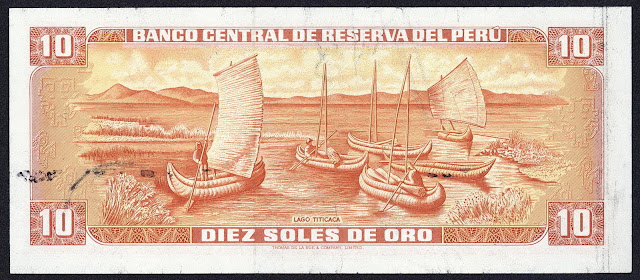Peru Banknotes 10 Soles de Oro banknote 1976 Inca Garcilaso de la Vega
Central Reserve Bank of Peru - Banco Central de Reserva del Perú
Obverse: Portrait of Garcilaso Inca De La Vega and Jesus Christ on the Cross at right, House of Garcilaso Inca De La Vega in Cusco at left, Coat of arms of Peru at center.
Reverse: Lake Titicaca (Lago Titicaca) with ancient Peruvian sailing reed boats.
Original Size: 156 x 67 mm.
Printer: Thomas De La Rue & Company Limited, London, England.
Peru Banknotes - Peruvian Paper Money
1968-1975
5 Soles de Oro 10 Soles de Oro 50 Soles de Oro 100 Soles de Oro
200 Soles de Oro 500 Soles de Oro 1000 Soles de Oro
200 Soles de Oro 500 Soles de Oro 1000 Soles de Oro
House of Garcilaso Inca De La Vega in Cusco
Inca Garcilazo de la Vega was born on April 12th in 1539 in Cusco. He was the son of the Spanish captain Gracilazo de la Vega y Vargas and the princess of Cusco Chimpu Occllo. He is the author of two pieces "Comentarios Reales" and the "Florinda del Inca", both originated by the necessity of saving the history of the Inca Empire beyond the eurocentered vision that most of the time saw the features of this culture in an offensive way. Currently, this house is the base of the Museo Histуrico Regional (Historic Regional Museum) where we can find a collection of canvas of the Academy of Cusco.
Some time after the Spanish foundation, this manor house was assigned to the Captain Sebastian Garcilaso de la Vega married to the "сusta" Isabel Chimpu Ocllo: parents of the future author of the "Comentarios Reales de los Incas" who was born here on April 12th in 1539.
Garcilazo lived in this house until 1560. That year he went to Spain and stayed there permanently. Its patios and rooms were scenery of long discussions with some maternal relatives whose narratives were the base of his stories about the Inca Empire. In the horrible years of the civil wars, the large house was the shelter of the future writer, his mother and his "ayo" when the Captain Sebastian Garcilazo, his father, had to run away from Cusco to join the army of the viceroy Blasco Nuсez de Balboa in 1544. Then, the rebels put a fence around his house. According to the story lived by the Inca: " they did not leave anything not even something as valuable as a coin, nor a native nor a service native because they threatened them with death punishment if they entered the house". The kid Garcilazo and the people who stayed inside could have died if some kind people in Cusco had not brought food thanks to the secret passages they used. Even worse, going back to the Inca words: "Hernando Bachicao, captain of artillery, shot us from his house…and then eight months past".
The House structure
It is not only important historically but also architectonically as it was built over an old Inca terrace. It has an especial portico open to the street before the entrance hall. It is a gallery in the way of loggia that was blocked for many years until a recent restoration work cleaned the arches and recovered their original appearance. On the other hand, the open balcony on one corner is a republican detail. As they used to be, the rooms are distributed around a big patio and some impressive stairs leaded upstairs. Most part of the rooms has been adjusted as exhibition rooms when they became the base of the Museo Historico Regional (Regional Historic Museum).

